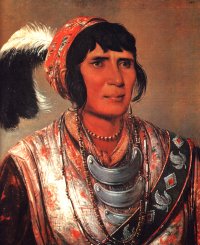

Osceola was born in Alabama sometime between 1800 - 1806. Although neither a hereditary nor an elected chief, Osceola was the defiant young leader of the Seminole in their resistance to Indian emigration. Osceola's name was derived from the Indian term "Asiyahola," the cry given by those taking the ceremonial black drink that was supposed to cleanse the body and spirit. In 1835 he plunged his knife into the treaty he was asked to sign that would move his people from their swamplands in the Southeast to the unoccupied territory west of the Mississippi. This action precipitated the Second Seminole War--a seven-year game of cat-and-mouse in the Florida swamps against federal troops.
Tricked into talking peace, Osceola was captured in 1837 while carrying a white flag of truce and was imprisoned in Fort Moultrie, South Carolina. Several historical accounts say Osceola was able to escape through the prison bars by starving himself but was later re-captured.
He had fought as a boy in the War of 1812. His ability and fiery spirit made him the symbol of resistance. His fighting tactics and daring brought many victories to his people over the U. S. Army. He was finally captured while under a "flag of truce". Osceola died in 1838 while imprisoned at Fort Moultrie, South Carolina.
